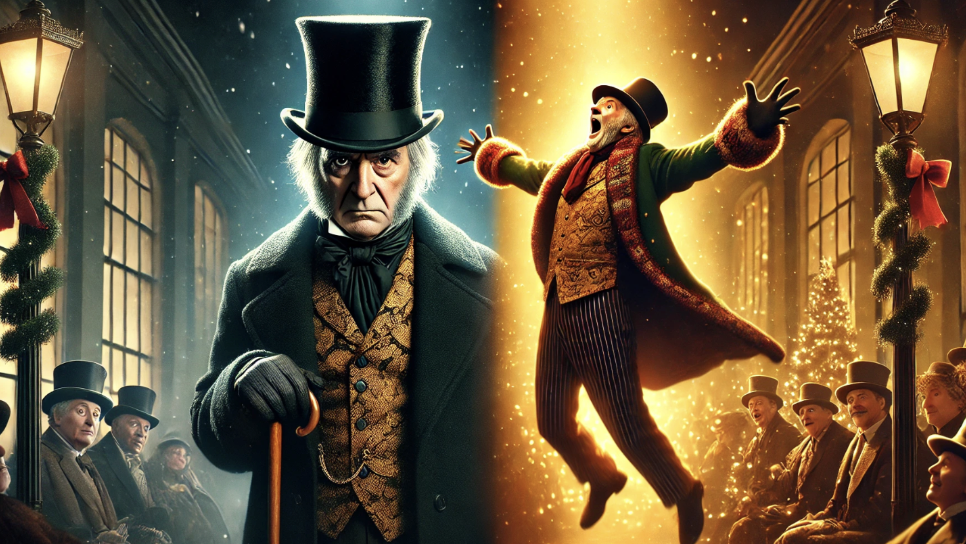Think about your favorite book or movie. What makes the characters stand out? Is it their character traits, their transformation, or the way they push the story forward? Some characters remain the same from beginning to end, while others undergo significant change. When a character remains static, the narrative can focus more on the hero’s adventures and the plot’s development. This difference highlights the contrast between static character definition and dynamic character definition.
Understanding character development is crucial for both writers and readers. While dynamic characters evolve throughout the story, static characters provide stability and help drive the narrative. Not every character needs to undergo a dramatic transformation. In this article, we’ll explore the static and dynamic character definitions and how both types play vital roles in crafting compelling stories.
What Are Character Types?
Character types refer to the various categories that characters in a story can be classified into based on their traits, behaviors, and development throughout the narrative. Understanding character types is essential for writers to create well-rounded and engaging characters that drive the plot forward. In literature, characters can be broadly classified into different types, including flat vs round vs static vs dynamic characters. Flat characters tend to lack depth, often remaining one-dimensional, while round characters are more fully developed with complex personalities.
On the other hand, static characters remain unchanged throughout the story, providing stability, while dynamic characters undergo significant development and change, making their evolution central to the narrative. By understanding these distinctions, writers can craft a balanced narrative that features both complex characters and compelling transformations.
Static vs. Dynamic Characters: A Fundamental Difference
In storytelling, characters can generally be categorized as either static or dynamic based on the character’s personality. A static character remains unchanged, maintaining the same personality, beliefs, and traits from the beginning to the end of the story. They provide consistency and often serve as comic relief, mentors, or obstacles to the protagonist.
On the other hand, a dynamic character refers to someone who undergoes a character arc. They experience an internal change, whether through lessons learned, struggles overcome, or realizations about themselves or the world. This growth makes them feel well-developed and relatable.
For example, consider James Bond—a classic static character. No matter how many missions he completes, his personality traits remain largely the same. In contrast, Harry Potter goes from an uncertain boy to a confident hero, making him a dynamic protagonist.
What Is a Dynamic Character?
Definition & Key Traits
A dynamic character changes significantly throughout the narrative. This change is often a result of:
- Personal growth or self-discovery
- Overcoming internal conflict
- A shift in beliefs or values
Their evolution is central to the overall narrative, making them essential for deep, immersive storytelling. Various dynamic character examples illustrate characters that undergo significant transformations throughout their narratives.
Examples of Dynamic Characters
- Ebenezer Scrooge (A Christmas Carol)—From greedy miser to generous man
- Simba (The Lion King)—From scared exile to rightful king
- Elizabeth Bennet (Pride and Prejudice)—From prejudiced to self-aware
These characters don’t just react to events—they change because of them.
What is a Static Character?
Definition & Key Traits
A static character does not undergo significant change. This doesn’t mean they lack depth or importance. Instead, their consistency helps anchor the story. Many static characters serve as foils, mentors, or constants in the protagonist’s life. Unlike a flat character, who is often one-dimensional and lacks complexity, static characters can still be well-developed and integral to the narrative.
Examples of Static Characters
- Alice (Alice’s Adventures in Wonderland)—Despite her wild journey, she remains curious and unchanged.
- Sherlock Holmes—Brilliant, arrogant, and unaffected by the mysteries he solves.
- The Joker (The Dark Knight)—A chaotic villain who never learns or changes.
While dynamic characters experience growth, static characters remain static, offering balance to the story. A static character example is Professor Lupin from the Harry Potter series, who maintains consistent traits and serves important roles without significant changes.
Dynamic vs Static Characters: Key Differences
Dynamic and static characters serve different purposes in storytelling, each playing a crucial role in shaping the narrative.
A dynamic character undergoes significant growth and change throughout the story. Their transformation is often driven by internal conflict, experiences, or realizations that reshape their personality, beliefs, or actions. Characters like Harry Potter, Katniss Everdeen, and Simba evolve as they face challenges, making their journeys engaging and relatable. Their development is often central to the plot, influencing the direction of the story.
In contrast, a static character remains unchanged from beginning to end. They do not experience major internal struggles or personal growth, but this consistency serves an important function in storytelling. Static characters provide stability, contrast, or thematic reinforcement, ensuring that the focus remains on the transformation of dynamic characters. James Bond, Sherlock Holmes, and Alice (from Alice’s Adventures in Wonderland) are examples of static characters who remain true to their core traits, even as the world around them shifts.
Not all characters need to change for a story to be compelling. Some of the most memorable narratives use a mix of both static and dynamic characters, with each playing a significant role. Importantly, static characters are not always minor or antagonistic—they can be just as essential to the plot as those who undergo dramatic change.
Character Development and the Character Arc
The character arc is the journey a dynamic character takes. This growth can be:
- Positive: Overcoming fears, maturing, or becoming a hero (e.g., Luke Skywalker).
- Negative: Falling into corruption or tragedy (e.g., Anakin Skywalker).
- Flat: Remaining steadfast while the world around them changes (e.g., Indiana Jones).
Static characters serve a different purpose, ensuring the protagonist’s transformation is emphasized. Writers often write static characters to highlight the adventure rather than character development.
The Role of Static Characters
Static characters play a crucial role in a story, providing a stable perspective and serving as a foil to dynamic characters. They offer consistency and continuity, helping to anchor the narrative and highlight the growth and change of dynamic characters. Static characters can also be used to explore the human condition and the complexities of life, offering a unique perspective on the story’s themes and plot.
While static characters may not undergo significant change, they can still be well-rounded and complex, with their motivations and backstories. For example, Sherlock Holmes remains brilliant and arrogant throughout his adventures, yet his consistency provides a stable foundation for the unfolding mysteries. Similarly, Alice in “Alice’s Adventures in Wonderland” remains curious and unchanged despite her wild journey, offering a sense of continuity amidst the chaos.
Understanding the role of static characters can help writers create a rich and immersive narrative with a diverse range of characters, ensuring that the story remains engaging and balanced.
The Value of Dynamic Characters
Dynamic characters are the lifeblood of any narrative, imbuing it with unpredictability and depth. They undergo significant transformation, often as a result of experiences or insights gained throughout the story. This evolution can drive the plot forward, create tension and conflict, and evoke emotional resonance and connection with the reader.
Dynamic characters can serve as a model for personal growth and development, offering a powerful exploration of the human condition. For instance, Ebenezer Scrooge’s transformation from a greedy miser to a generous man in “A Christmas Carol” provides a compelling narrative of redemption and change. Similarly, Simba’s journey from a scared exile to the rightful king in “The Lion King” showcases personal growth and the reclaiming of one’s destiny.
Understanding the value of dynamic characters can help writers create engaging and memorable stories that resonate with readers. By incorporating dynamic characters into their narrative, writers can craft a story that is both compelling and impactful, ensuring that the characters’ journeys leave a lasting impression.
Famous Examples: Static vs. Dynamic Characters in Literature
Ebenezer Scrooge – A Christmas Carol (Dynamic)
At the start, Scrooge is greedy and heartless. By the very end, he undergoes a personal transformation, becoming generous and kind. For static character examples, consider characters who remain unchanged throughout the story, serving to highlight the protagonist’s development.
Alice – Alice’s Adventures in Wonderland (Static)
Despite experiencing strange adventures, Alice remains curious and unchanged, showing that not all characters need to change for a good story to work.
Other Examples:
- Dynamic: Katniss Everdeen, Anakin Skywalker, Frodo Baggins
- Static: The Joker, Jay Gatsby, Indiana Jones
Both types contribute to compelling narratives, proving that not all characters need drastic growth to be memorable. Flat characters, while lacking depth and transformation, often serve as secondary characters but can still play significant roles in a narrative.
Writing Great Characters: Should You Write Static or Dynamic Characters?
A well-rounded character, often referred to as a round character, doesn’t always need a dynamic character arc. Writers should ask:
- Does this character need to change for the story to work?
- Is their role better suited as a foil or constant presence?
- Will their consistency or transformation serve the plot better?
Some of the most engaging stories use a mix of both character types. A static love interest might push the protagonist’s development, while a dynamic antagonist can heighten tension.
Why Both Character Types Matter
Whether a character undergoes a significant change or remains unchanged, both static and dynamic characters play a vital role in storytelling. Dynamic characters drive personal transformation, while many static characters, often round characters, provide consistency and contrast, enhancing the central themes of the narrative.
Think about your favorite stories—who changed the most? Who stayed the same? More importantly, how did that affect the overall narrative?
At the end of the day, the best characters—whether static or dynamic—are the ones that stay with us long after the story ends. Want to create compelling characters that leave a lasting impact? Spines helps you craft dynamic arcs and unforgettable personalities. Start writing with Spines today!
Your Publishing Journey Awaits – Start NowFAQs – Static vs Dynamic Characters
Q1: What is the difference between static vs dynamic characters?
Static characters remain unchanged throughout the story, keeping the same beliefs, personalities, and traits. They provide stability and often serve as mentors, foils, or constants in the protagonist’s journey. Dynamic characters, on the other hand, undergo significant change—whether in their mindset, emotions, or personal beliefs. This transformation is crucial to the story’s character development and often defines the character arc.
For example:
- Static Character: James Bond – remains the same, confident spy in every film.
- Dynamic Character: Harry Potter – grows from an uncertain boy into a powerful wizard.
Q2: What are examples of static characters?
Static characters can be main characters, secondary characters, or antagonists who do not undergo significant internal change. Some great examples include:
- Alice (Alice’s Adventures in Wonderland) – Curious and adventurous, but remains unchanged despite her bizarre journey.
- Sherlock Holmes – His intelligence and arrogance are consistent throughout his stories.
- The Joker (The Dark Knight) – Represents chaos and never experiences personal growth or change.
- James Bond – Always remains the cool, capable spy, no matter the mission.
Even though they don’t change, static characters serve an important purpose in keeping the story balanced and supporting the arcs of other characters.
Q3: Is Shrek a static or dynamic character?
Shrek is a dynamic character because he undergoes a major transformation in both his personality and outlook on life. At the beginning of the story, Shrek is a grumpy, isolated ogre who pushes people away, preferring to live alone in his swamp. However, through his journey with Donkey and Fiona, Shrek learns to trust others and open up emotionally. Over time, he realizes that love and friendship are valuable, and by the end of the film, he embraces these qualities. His growth from a fearful, defensive character to someone who cherishes relationships proves that he is not just a static, unchanging figure. Shrek’s character arc—his evolution from solitude to companionship—makes him a classic example of a dynamic protagonist.
Q4: Is Harry Potter a static or dynamic character?
Harry Potter is a dynamic character because he undergoes significant emotional and personal growth throughout the series.
- He starts as a naive, insecure boy who is unsure of his place in the wizarding world.
- Over time, he learns about friendship, bravery, and sacrifice.
- By the final book, he has grown into a strong leader, willing to sacrifice himself for others.
His character development is central to the story, making him one of literature’s most famous dynamic protagonists.
Q5: What is a dynamic character example?
A dynamic character changes due to the events of the story. Some great examples include:
- Ebenezer Scrooge (A Christmas Carol) – A greedy miser who learns the value of kindness and generosity.
- Simba (The Lion King) – Runs from responsibility but grows into a true king.
- Elizabeth Bennet (Pride and Prejudice) – Overcomes her initial prejudices and matures emotionally.
- Katniss Everdeen (The Hunger Games) – Starts as a reluctant hero and evolves into a revolutionary leader.
These characters do not stay the same—they learn, struggle, and grow, making them relatable and compelling.
Q6: Why is Alice (Alice’s Adventures in Wonderland) a static character?
Alice is a static character because, despite all the bizarre adventures she faces, her personality remains unchanged. She starts as a curious, adventurous girl, eager to explore the strange world she finds herself in. Even as she encounters peculiar characters like the Mad Hatter, the Cheshire Cat, and the Queen of Hearts, Alice remains level-headed and inquisitive, never losing her calm demeanor. By the end of her journey, she wakes up the same person, unaffected by the fantastical experiences in Wonderland. Her lack of change throughout the story highlights the chaotic nature of Wonderland, making her a strong example of a static protagonist.
Q7: What is the role of flat vs round vs static vs dynamic characters in a story?
The role of flat vs round vs static vs dynamic characters varies depending on the story. Flat characters are often one-dimensional, while round characters are complex and multifaceted. Static characters provide consistency and stability, while dynamic characters drive the narrative forward through their development and change.
Q8: Should you write static or dynamic characters?
A well-rounded story often includes both static and dynamic characters. When deciding which type to write, consider:
- Does the character’s growth impact the story? If yes, they should be dynamic.
- Is their purpose to provide consistency or contrast? If so, they might be static.
- Will their personality remain unchanged for a reason? Some static characters, like The Joker, are more effective when they stay the same.
Great stories mix both character types to create depth, contrast, and engagement.








